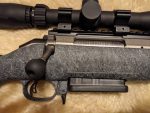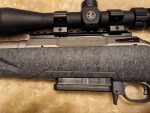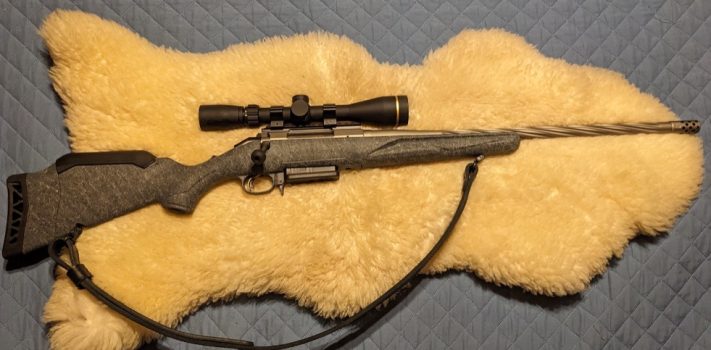The Ruger American Rifle Generation II in 6.5 Creemoor is highly accurate and light, with an easily gripped and highly adjustable stock. The 20 inch spiral fluted barrel is visually striking, the bolt cycles smoothly, and the 3 position tang safety is easy to operate and intuitive. At 6.5 pounds, the rifle would be easier to carry than most on a long day in the field.
With a manufacturer-suggested retail price of $729 at the time of this writing, and widely available for less, the rifle offers an excellent value for the money. If you are looking for a good bolt action rifle for hunting medium sized game, I recommend that you seriously consider this one.
Background
The most accurate rifle that I ever fired over short range was a Ruger American Ranch Rifle chambered in 7.62×39. I reviewed that rifle for SurvivalBlog back in 2021. Using inexpensive steel-cased ammo, it was able to create 3-shot-1-hole groups at 25 yards with monotonous regularity. I have often wondered if I made a mistake when I let that rifle slip through my fingers. But I wanted something chambered in a cartridge with a flatter trajectory over longer ranges. I also felt that the flat comb on the stock did not make sense for a rifle that was not equipped with iron sights.
When I saw that the stock on the new Ruger American Generation II rifle came with an adjustable comb, I decided that they might be on to something good. I asked Ruger if I could borrow a sample chambered in 6.5 Creedmoor for testing and evaluation. They were kind enough to agree. When a sample became available, they sent it to the gun store that handles my firearms transfers for me.
Opening the Box
A sticker on the box proudly proclaimed that 2024 is Ruger’s 75th anniversary. Ruger certainly has accomplished a lot since 1949, offering a wide assortment of innovative and highly effective firearms over the years.
The box contained the rifle in a plastic bag, the bolt, a polymer detachable box magazine with cover, a magazine latch assembly tool, a cable lock, the manual, a 75th-anniversary sticker, a conversion kit offer card for old model single action revolvers, an NRA membership offer card, a Ruger sticker, 2 different shopruger.com cards, and a trigger guard tag explaining the 3 position safety.
 A removable stock spacer allows the length of pull to be adjusted from 13.75 to 12 inches, while another spacer raises the comb ½ inch to improve sight alignment. Optional kits are available from shopruger.com to adjust the length of pull to 12.75 or 13.25 inches, or to raise the comb 5/8 or 3/4 inches. More and more companies are introducing easily adjustable stocks, and I heartily applaud this development. These new stocks are much more durable and pleasing in appearance than the duct tape and cardboard creations that I had been using previously to get a good cheek weld on the rifles I was testing.
A removable stock spacer allows the length of pull to be adjusted from 13.75 to 12 inches, while another spacer raises the comb ½ inch to improve sight alignment. Optional kits are available from shopruger.com to adjust the length of pull to 12.75 or 13.25 inches, or to raise the comb 5/8 or 3/4 inches. More and more companies are introducing easily adjustable stocks, and I heartily applaud this development. These new stocks are much more durable and pleasing in appearance than the duct tape and cardboard creations that I had been using previously to get a good cheek weld on the rifles I was testing.
The gunmetal gray Cerakote finish on the barrel and action is quite attractive. The action comes with an optics rail installed, which is highly appropriate for a rifle that does not come equipped with iron sights. A stainless steel bolt is a suitable match for the synthetic stock and for the Cerakote finished barreled action: together they provide a good measure of weather resistance. The “gray splatter” finish on the synthetic stock provides a comfortable and easily gripped surface.
It took some practice to get comfortable with magazine insertion and removal. I recommend inserting and removing the magazine a few dozen times before range or field use to become familiar with the process. The magazine well was also just a smidgen tight at first, but improved significantly during the course of the familiarization process.
The 3-round polymer magazine is AICM compatible. Accuracy International Chassis compatible magazines are standardized, sturdy, reliable and widely available in metal or polymer from a large number of manufacturers in a good variety of capacities. Unfortunately, they are also single-stack. Peter Paul Mauser introduced a highly reliable double stack magazine to his bolt action rifle in 1893. It seems to me as a result that single stack magazines in bolt action rifles are now out of date. A double stack 3 or even 4 round magazine in this rifle might be able to sit flush with the bottom of the receiver, making it less likely to snag on branches and other passing objects. I wish that Accuracy International had popularized a double stack rather than a single stack magazine system.
The spiral fluted 20 inch barrel is threaded and comes with an installed muzzle brake. The muzzle brake is conveniently stamped “5/8-24″ in case you want to replace it with a thread protector.
Reading the Manual
The manual is 60 pages long including the front and back covers. It begins with the boring state-by-state legally mandated warnings. These warnings are a great cure for insomnia. I recommend that Ruger move them to the back of the manual for the benefit of those readers who wish to stay awake to read the rest of the manual
There were a number of interesting tidbits in the manual:
The 3-position safety can be placed in the safe-locked mode, which does not allow the bolt to be cycled or the trigger to be pulled; the safe-unlocked mode, which allows the bolt to be cycled but does not allowed the trigger to be pulled; or the fire mode, which allows both the bolt to be cycled and the trigger to be pulled.
The trigger can adjusted from approximately 3 to 5 pounds in pull weight.
The manual recommends using only factory loaded ammunition. I understand why Ruger’s lawyers want this language inserted into the manual, but it ignores the superiority of quality reloads over factory loaded ammunition.
There are good instructions for clearing jams and misfires.
Routine cleaning only requires the removal of the magazine and bolt.
There are good instructions for removing the bolt shroud from the bolt, and the barreled action from the stock.
There are tips for accuracy on page 33, and the user is referred to customer service for further help with this issue.
There is a good section on function testing, with a link to a video.
The rear sling swivel stud holds the recoil pad assembly in place. This is very clever. It puts the sling swivel stud to good use while placing it at a more convenient angle than is typical for most rear sling swivel studs.
There is a link to a cleaning video.
There are excellent exploded drawings and a parts list.
Mounting a Scope
 I initially installed a Leupold VX-Freedom 3-9X40mm Hunt Plex scope using a generic set of rifle rings. The generic rings placed the scope just a little too high for effective cheek weld utilizing the installed ½ inch comb. I switched to Leupold Rifleman medium rings instead, and they worked quite well. I then leveled the scope and tightened the rings evenly.
I initially installed a Leupold VX-Freedom 3-9X40mm Hunt Plex scope using a generic set of rifle rings. The generic rings placed the scope just a little too high for effective cheek weld utilizing the installed ½ inch comb. I switched to Leupold Rifleman medium rings instead, and they worked quite well. I then leveled the scope and tightened the rings evenly.
Installing a Sling
I installed a 1791 Gunleather Premium Rifle Sling using a pair of Uncle Mike’s Quick Detachable Super Swivels. I enjoyed the convenience of the sling while transporting the rifle to the improvised range behind my barn, to the cleaning table, to the gun safe, and wherever else I wished to transport it without placing it in a case.
Trigger Pull Weight
I tested the trigger pull weight using a Ready Up Gear Digital Trigger Pull Weight Gauge. The five test measurements varied between 3.13 pounds and 3.56 pounds, with an average of 3.36 pounds and a median of 3.35 pounds.
Range Session 1
 It was a sunny but cool afternoon in early spring. The temperature was 38 degrees Fahrenheit, with a gusty breeze from the west. I made my way to the improvised range behind the pole barn, and prepared for an initial zero of the rifle from 25 yards. This would significantly increase my chances of getting shots on paper during my later range work from 100 yards.
It was a sunny but cool afternoon in early spring. The temperature was 38 degrees Fahrenheit, with a gusty breeze from the west. I made my way to the improvised range behind the pole barn, and prepared for an initial zero of the rifle from 25 yards. This would significantly increase my chances of getting shots on paper during my later range work from 100 yards.
 I bore sighted the rifle, and then loaded a single round of Sellier & Bellot 142 grain HPBT. The bullet hit 2.5 inches below the point of aim. The muzzle brake made the report of the rifle quite loud in the bowl-shaped area in which my range is located. My ears were ringing in spite of the hearing protection that I was wearing. I decided that I would replace the muzzle brake with a thread protector before testing that rifle at the 100-yard indoor range of the local rod and gun club.
I bore sighted the rifle, and then loaded a single round of Sellier & Bellot 142 grain HPBT. The bullet hit 2.5 inches below the point of aim. The muzzle brake made the report of the rifle quite loud in the bowl-shaped area in which my range is located. My ears were ringing in spite of the hearing protection that I was wearing. I decided that I would replace the muzzle brake with a thread protector before testing that rifle at the 100-yard indoor range of the local rod and gun club.
After several 3 shot groups, I had a good preliminary zero. I took the rifle inside and cleaned it with OGRE EnviroClean FA Gun Cleaner and BreakFree CLP.
Removing the Muzzle Brake
The muzzle brake was horribly difficult to loosen. I ultimately had to clamp the barrel in a vise with a leather glove to protect its finish, and use an adjustable wrench to twist the brake loose. The forces involved were so significant that I was worried that I might damage the barrel, or at least move the zero. I am happy to report that there were no signs of any damage to the rifle or disruption of the zero in my subsequent testing.
Range Session 2
I made my way to the 100 yard indoor range of the local rod and gun club.
The club must have had some powerful intake fans running in the lanes, because when I removed the lid from the shooting port for my lane, it felt like I was opening the door of an icy wind tunnel. Part way through the session, someone must have turned off the fans, because the wind died down. Eventually, I thawed out.
I am not sure if it was due to less wind, to breaking in the barrel, to becoming more familiar with the rifle, to additional bench rest practice, or to using ammo that the rifle liked better toward the end of the range session, but my groups steadily improved throughout the range session. My first and worst group was 2.3 inches in size, while my final and best group was 0.49 inches in size. That last group was tie for my best group ever, so I was pretty happy with it.
The ammunition types that I tested in order of use were Sellier & Bellot 142 grain HPBT, Winchester Target & Practice 125 grain open tip, Norma Whitetail 140 grain SP, and Hornady Match 140 grain ELD Match.
Because the rifle is relatively light, felt recoil was stronger than is typical for most rifles chambered in 6.5 Creedmoor. Taking off the muzzle brake to reduce noise at the indoor range did not help, of course. And most people who have to carry a rifle very far in the field will happily accept a little extra recoil in order to get rid of a pound or two of extra weight.
After the range session, I returned home and gave the rifle a final cleaning.
Conclusions
The Ruger American Rifle Generation II in 6.5 Creemoor is an outstanding rifle well suited for field use. It is accurate, light, and weather-resistant. As a bonus, it looks very nice as well. If you will be carrying a rifle for long distances in pursuit of medium-sized game, this one would be an excellent choice.
Disclaimer
Ruger was kind enough to loan me a sample of their American Rifle Generation II in 6.5 Creedmoor for testing and evaluation. 1791 Gunleather provided me with a sample of their Premium Rifle Sling for another article that I am preparing. Ready Up Gear Provided me with a sample of their Digital Trigger Pull Weight Gauge for a previous article. OGRE Manufacturing provided me with a sample of their EnviroClean FA Gun Cleaner for a previous article. I tried not to allow the kindness of any of these vendors to interfere with the objectivity of my review, and feel that I have succeeded. I did not receive any other financial or other inducement to mention any vendor, product, or service in this article.










